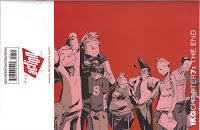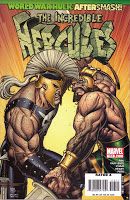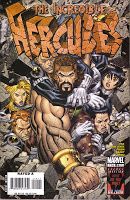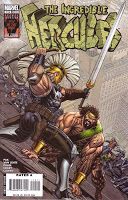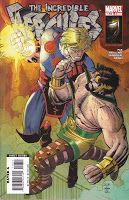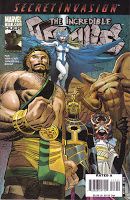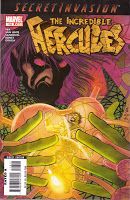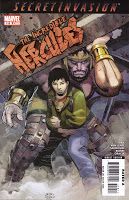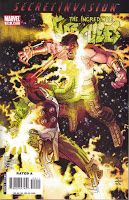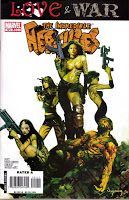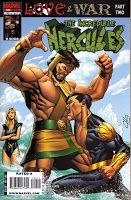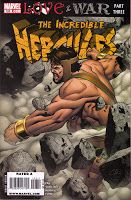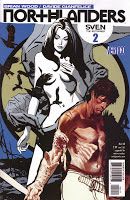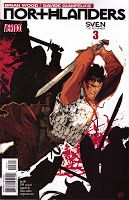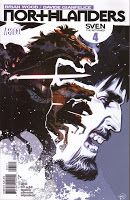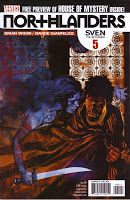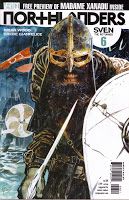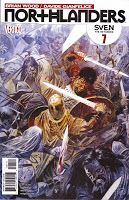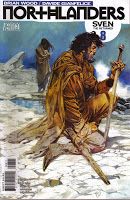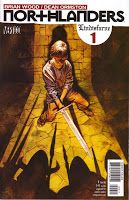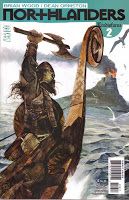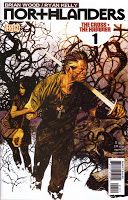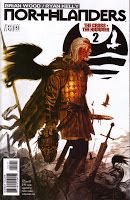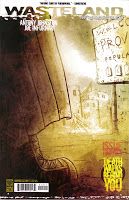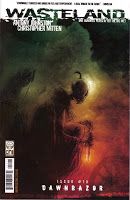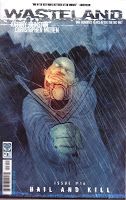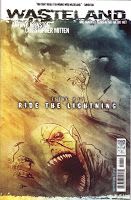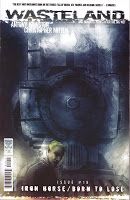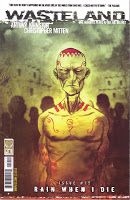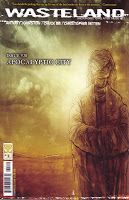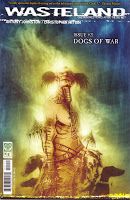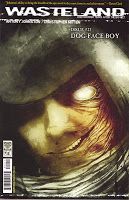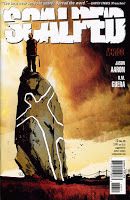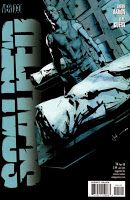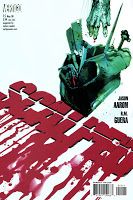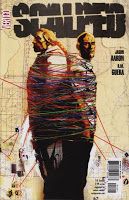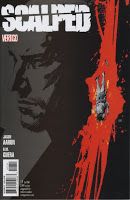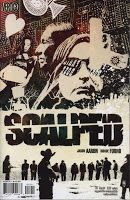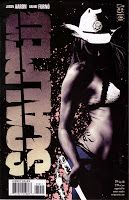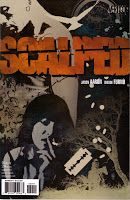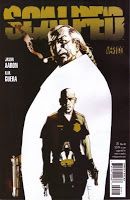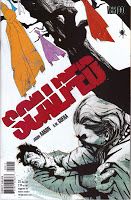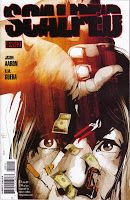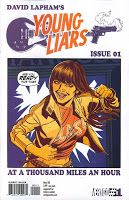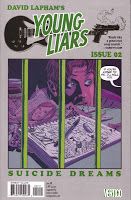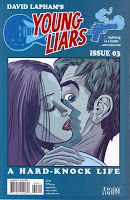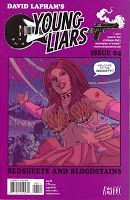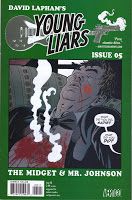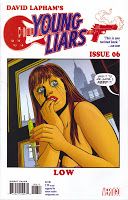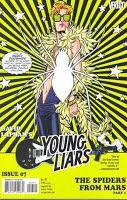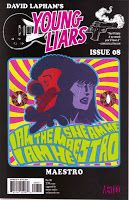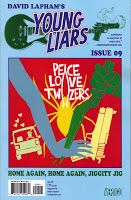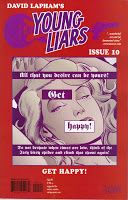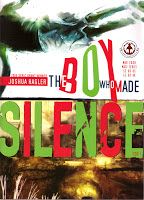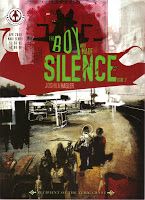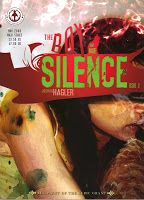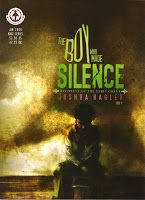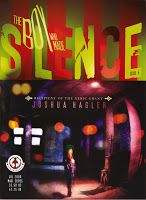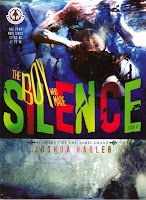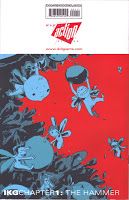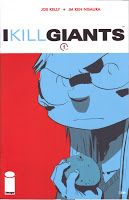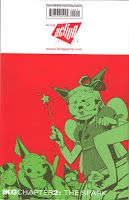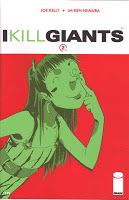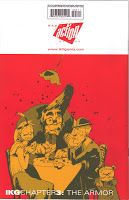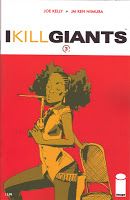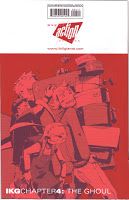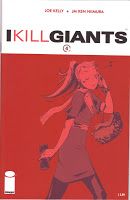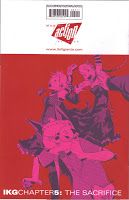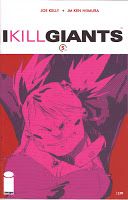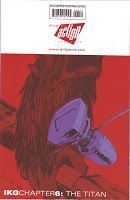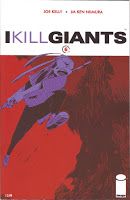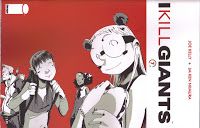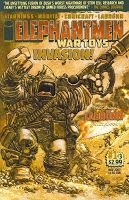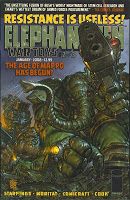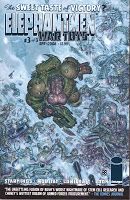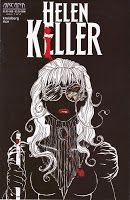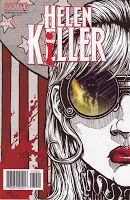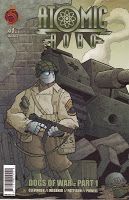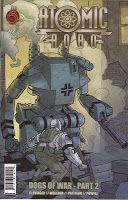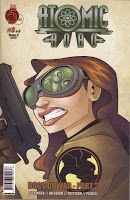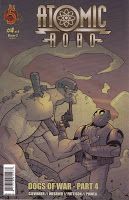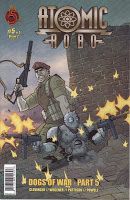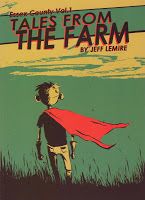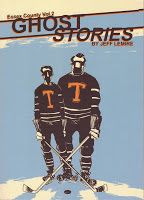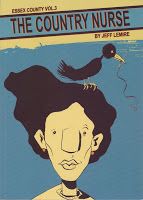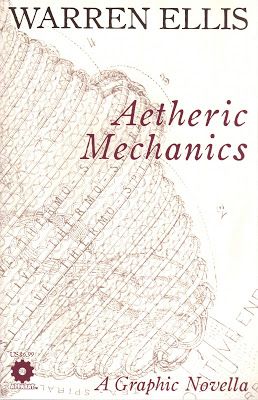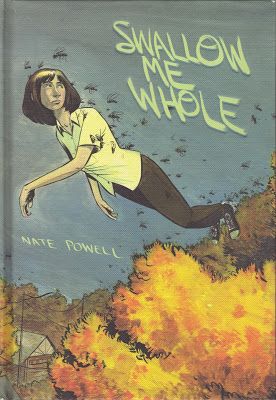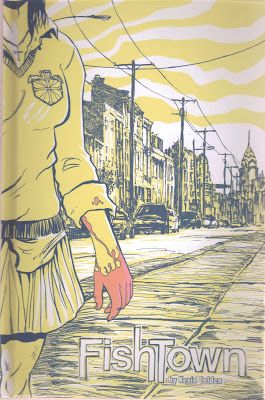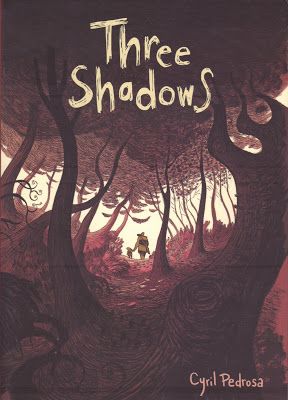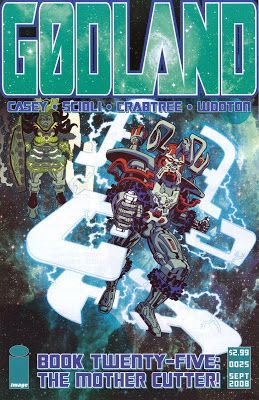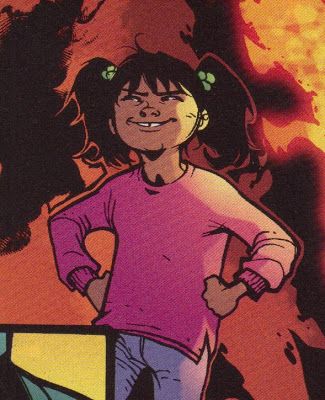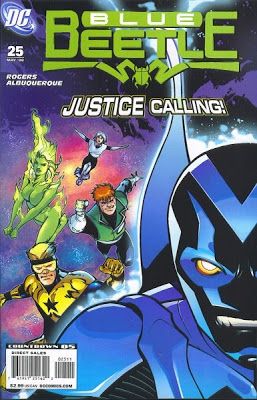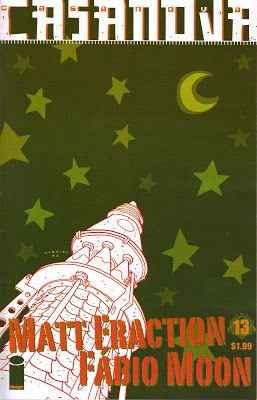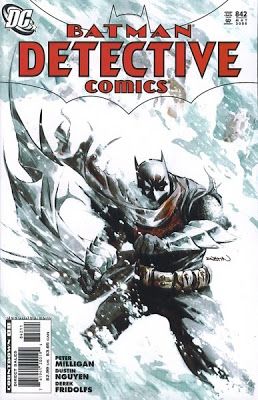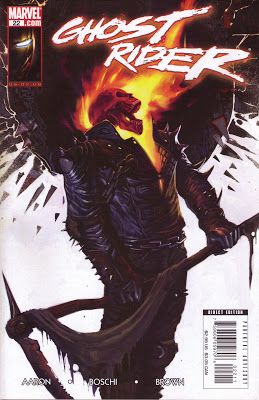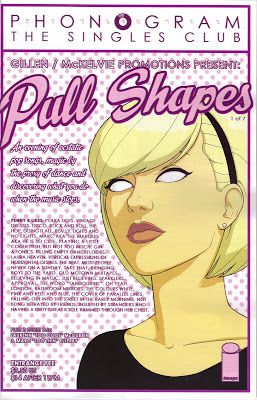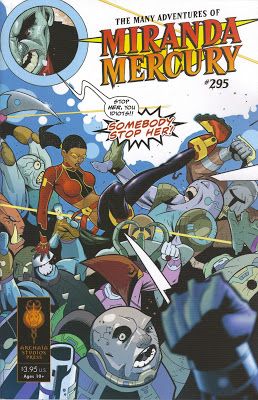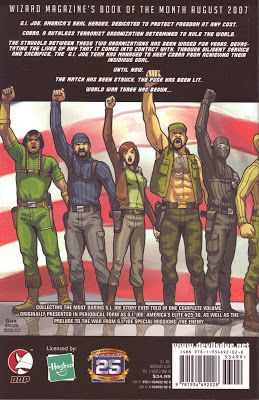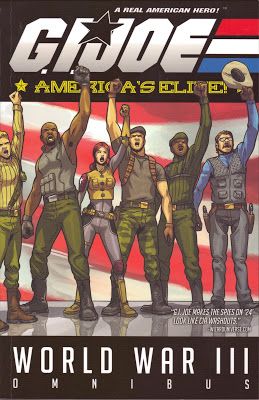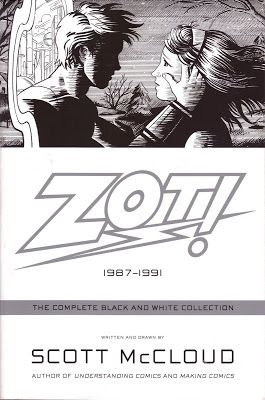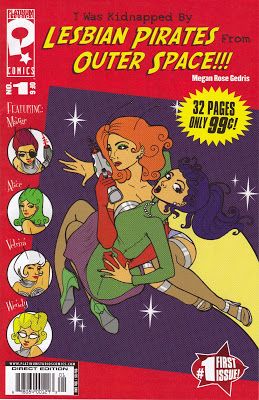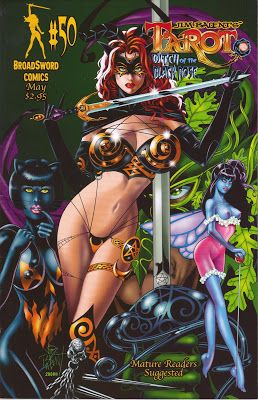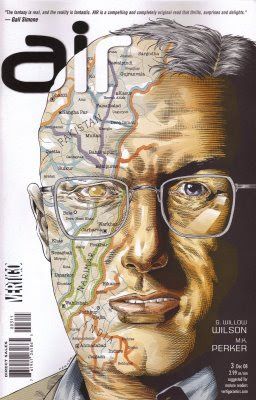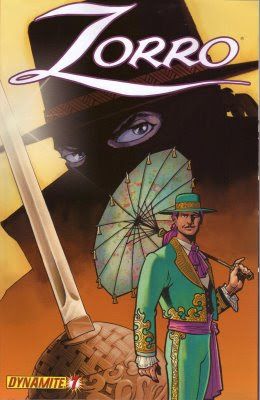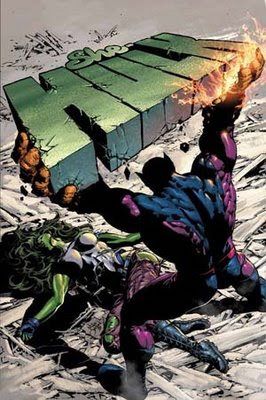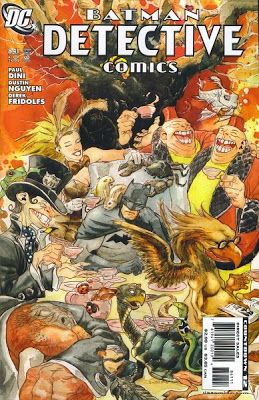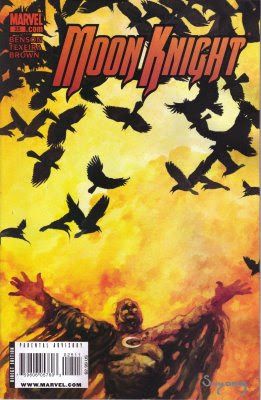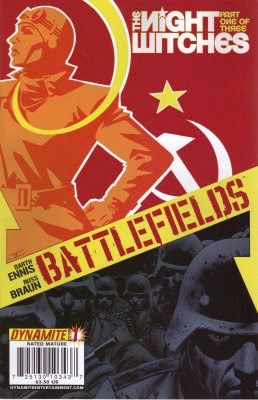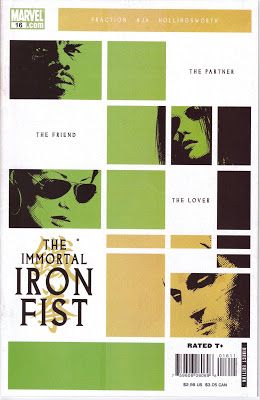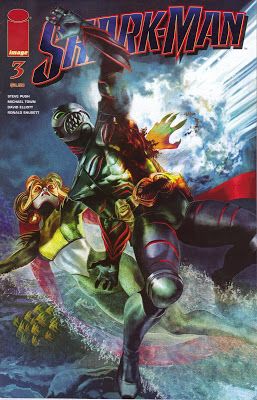Is mine, of course! Oh, and I apologize for the length. You do know how I like to go on, right?
2008 was an odd year in comics. I enjoyed a lot of "mainstream" work even as I continued to find DC and Marvel superhero books more and more boring. Several comics from smaller publishers seemed to disappear this year, and I was left with stuff from the Big Four (obviously, there are exceptions, but in general). On the one hand, this is not a bad thing, as it means some of the larger publishers are actually putting out stuff that goes beyond superheroes and is worth checking out, but on the other hand, it's kind of depressing that it seems like small presses don't survive long enough to have ongoing series. Of course, that means we get some nice mini-series, and I guess that's not a bad thing. The other odd thing about the year was that there wasn't a lot of truly great original graphic novels out there, at least what I read. I got a lot of entertaining OGNs, and a lot of collected editions of older stuff, but as I went back and looked at the year, very few original graphic novels truly blew me away. I suppose it's just my tastes and that if I ever get around to reading Bottomless Belly Button (as an example), I might be knocked down by its genius, but it was a weird year for longer works. I hope it was just my experience, because I would love it if more creators did longer work so they could escape the grindstone of monthlies. But that's a topic for another post!
I always have to add a disclaimer: these are the best of what I read this year. Of course that's true for any list of this sort, but I'm always amused when I read people who say theirs are the "best" comics when they haven't actually read every comic. Unless, of course, that person is Our Dread Lord and Master, who of course has comics downloaded directly into his brain. I read a lot of comics this year - over 500 monthly issues, and dozens of longer collected editions or OGNs, but I'm certainly not going to claim to be comprehensive. So here's the best of what I read in 2008. (And I always have to warn everyone: THERE MAY BE SPOILERS DOWN BELOW!!!!)
Best Ongoing Series. Here's a strange category. I liked several ongoing series, but there was nothing that stood head and shoulders above the rest. So this was tough, figuring it out. Luckily, I'm all about figuring things out!
1. The Incredible Hercules (issues #113-123). This may or may not stand the test of time, but right now, Greg Pak and Fred van Lente's adventures of Hercules and Amadeus Cho across the Marvel Universe is the best ongoing series out there. It's very funny, but also filled with intense action and some incredibly devastating moments. It features two wonderfully-written and completely different characters forming a buddy-buddy bond that is completely realistic, even in the midst of the craziness. The stories are cosmic and/or big in just the right, comic-booky way, i.e. they are things that could only look real in comics, not movies (too expensive, too much cheesy CGI). There isn't a consistent artist on the book, but Khoi Pham (who drew the aftermath of World War Hulk), Rafa Sandoval (who drew the Skrull epic), and Clayton Henry (who drew the Atlantean epic) have been very strong, with Sandoval, especially, doing a wonderful job with the cosmic grandeur of the Skrull pantheon. Finally, it's little things that make the comic wonderful - the identity of the Skrull infiltrator, the Japanese god who speaks in haiku, Amadeus's desire for sex overriding his common sense. This is the most consistently entertaining comic on the stands right now, and although others in this category might be more "classic," I have a feeling I'll still be re-reading this in 20 years and loving every panel of it.
2. Northlanders (issues #2-12). Some people have commented here that they don't see the appeal of Northlanders, and that's cool. I don't get that, but whatever. Northlanders isn't really an ongoing, either, in that the story arcs feature completely different characters and completely different artists. But Brian Wood's Viking epic fits into a general time period - the Viking Age, duh! - and gives Wood a chance to look at different themes that are universal to humanity, not just Vikings. In the first arc (issues #1-8), he examined what it means to return home after several years and find everything changed. It's a well-mined theme, to be sure, but placing it in context of a Viking returning from Constantinople, the center of the world in the 10th century, to the Orkney Islands, as far away from the center of the world as you could get, meant that Wood not only got to examine the "you can't go home again" angle but also look at a clash of cultures, even within the seemingly homogenous Viking community. The next story, "Lindisfarne" (issues #9-10), was a brutal critique of Christianity set against the backdrop of the first recorded Viking attack, that on Lindisfarne Abbey on the northeast coast of England. The latest arc, "The Hammer and the Cross," is a manhunt over the landscape of Ireland that brings in themes of self-determination and resistance to a ruling class. It's neat to see how Wood introduces all these modern themes while keeping the book firmly rooted in the Middle Ages. The artists have been stellar, too - Davide Gianfelice brought a windswept bleakness to the Orkneys, Dean Ormston made the Vikings mythic in the eyes of the boy who witnesses their attack on Lindisfarne, and Ryan Kelly's intricate linework make Magnus's quest for justice visceral and real. Northlanders is a fantastic comic, and I hope Wood continues it for as long as he cares to.
3. Wasteland (issues #14-22). Antony Johnston and Christopher Mitten's post-Apocalyptic epic is one of those books that gets better and better as it goes along, and while that means it might have lost readers early on (when even I admit it was a bit difficult to follow, as the characters weren't really differentiated from each other enough), this year it really hit its stride. Johnston has continued to expand the world in which the characters live, and has stretched out in the way he portrays them, from the experimental issue with (almost) all-Sand Eaters dialogue (a chore to read, but one that showed how brilliantly realized the world really is) to the introduction of the Dog Tribes and their canine-related slang. Mitten, meanwhile, continues to draw the heck out of anything Johnston throws at him, from weird dreams to big battles to weirdly painted tribespeople. His stark pencils make the landscape alive and threatening, a big plus in a series like this, where the characters are supposed to be almost dwarfed by the enormity of nature. According to Johnston, sales on the trades have picked up, so the book is safe for him to finish (he says it will run about 50 issues or so). Issue #25, which is coming up, is in full color and presumably will be a good place to jump on, if you're leery about spending coin on the trades. I have enjoyed this book from the beginning, but this year it really took off.
4. Scalped (issues #13-23). I used to buy Scalped in trade, but switched over to single issues because I was afraid it would get cancelled, and nobody wants that, do they? This year Jason Aaron gave us the rest of "Dead Mothers," a two-issue arc in which Dashiell Bad Horse succumbs to heroin use, and "The Gravel in Your Guts," a story about Lincoln Red Crow trying to become a better person and, ultimately, failing. What makes the comic so amazing is that nobody is all bad or all good - even an apparent monster like Red Crow. They are all shaped by their pasts and, just as important, their lives on the reservation, which changes everyone in ways most of us can't imagine. I have read some criticism from Native Americans that this series is just a rip-off of The Sopranos that is set on a reservation to make it "exotic," but although I'm not an Indian and therefore can't make that judgment, I don't understand that criticism. This shows people beaten down by circumstances and how the simple fact of their existence makes living that much harder. It doesn't take a rosy-colored view of Native Americans, but neither does it show them as stereotypical drunks and drug addicts. There is nobility in the characters, but as the series moves on, it becomes harder and harder for them to express it. Is it occasionally obvious? Maybe (the issue with Dino Poor Bear trying to leave the rez was the worst offender). But most of the time, Aaron and R. M. Guéra, whose gritty art brings this seedy world to life brilliantly, craft stories that reveal both the worst and the best in people - often in the same character. That's a neat trick.
5. Young Liars (issues #1-10). I'm still not sure what to make of Young Liars. "You place it Number Five on your 'best ongoing of 2008' list and you're still not sure what to make of it?" you might ask. Well, yes. The reason I'm not sure what to make of it is because David Lapham never takes his foot off the accelerator to let us reflect on what it is we're reading. Almost with every turn of the page, I read something that I can't believe saw print. Whether it's casual murder, horrifying drug use, or far, far worse (trust me), Young Liars pushes the envelope like nothing else on the stands right now. I honestly have no idea if it's any good, but what I do know is that I simply cannot stop reading it - it's that addictive. You can't say you can see any of it coming, and that goes a long way toward making it a great comic. I certainly like it, and I think it's good, but it could just be all one big clusterfuck. However, any comic that is this grand a clusterfuck deserves credit. You may not like Young Liars, but I guarantee you that you will not forget it. I simply can't wait to read it every month, and that's the mark of a good comic, I guess. But I could be wrong.
Well, that was ambiguous, wasn't it? Let's look at some Honorable Mentions in this category: Captain Britain and MI 13 by Paul Cornell and Leonard Kirk (a bit early to tell - only nine issues - but if it's still around next year, it might make the list - much like Secret Six); Casanova by Matt Fraction and Fábio Moon (excellent as usual, but too few issues meant it kind of slipped from last year); Criminal by Ed Brubaker and Sean Phillips (probably #6 on the list, to be honest); Dynamo 5 by Jay Faerber and Mahmud Asrar (the best pure superhero book around right now); Elephantmen by Richard Starkings (still very good, but interrupted by a mini-series - see below - and hampered by Moritat's departure); Fables by Bill Willingham and Mark Buckingham (still a favorite, but the war was a bit anticlimactic); Gødland by Joe Casey and Tom Scioli (a bit erratic this year, although the last issue was astonishing) Moon Knight by Mike Benson and Mark Texeira (probably in the Top Ten on the list); Rex Libris by James Turner (a wonderful, wonderful comic, but not quite as good as last year); Rex Mundi by Arvid Nelson and Juan Ferreyra (still my favorite comic, but like Rex Libris, not quite as good as last year); Secret Six by Gail Simone and Nicola Scott (see above).
Best Mini-Series.
1. The Boy Who Made Silence #1-6. Josh Hagler's mini-series shouldn't count, because only six of the planned 12 issues came out this year, but they're split into two discrete parts and Hagler hasn't started on the final six anyway. But it counts because this is an astonishing series, by far the most stunningly gorgeous comic that I read this year, and the fact that it hasn't gotten more love is distressing. Hagler tells the tale of Nestor Gudfred, who almost drowned in a Midwestern river and, when he's rescued, is discovered to have a strange power. This leads the townspeople to treat him much differently, with odd consequences for everyone. Hagler's prose continues to get better after a somewhat difficult first issue, as he backs off on so much of the second person he was using in issue #1 and sprinkles it throughout the issues effectively. Hagler creates fascinating characters and turns them loose, allowing them to live desperate lives that shows us why they would turn to Nestor as a savior. The story has gotten better and better, and Hagler's stunning art raises it even more. It's surreal without being impenetrable, gorgeously painted, and amazingly detailed. His scenes of the town are bleak yet beautiful, and his flashbacks show the tricks memory can play on us, as the characters are more grotesque than we usually see in comics. Hagler has created a astonishing comic book, one that changes the way we look at comics. If this had been the only comic released in 2008, it still would have been a wonderful year for comics. I have not seen if Markosia has released a trade of the first six issues yet, but you can buy the issues at their web site. Hagler plans to finish the story, and I, for one, cannot wait. The Boy Who Made Silence is brilliant.
2. I Kill Giants #1-7. The final issue came out in January, but before I wrote this, so I can confidently state that my reason for not picking mini-series that aren't finished (the end could be screwed up, no matter how good the set-up is) does not hold here. I Kill Giants is a wonderful book - Joe Kelly and JM Ken Niimura have created a beautiful comic about growing up, but one that doesn't get bogged down in a lot of soul-searching and navel-gazing. Barbara Thorson is the main character, a misfit who gets bullied at school but cares little about it as long as she can kill giants. She's keeping secrets about her home life, she has no friends until a new girl tries to break through her shell, and she fears the arrival of a Titan, which is far worse than a giant. Kelly does a marvelous job blending fantastical elements with brutal reality, and the giant-killing parts of the book help make the troubles in Barbara's home all the more gripping. We're never quite sure what's metaphorical and what's literal, which is part of the charm of the book, and the emotional pay-off is heart-breaking but uplifting at the same time. Niimura's sketchy, manga-influenced art is magnificent, as he shifts easily from the amazing to the mundane. Image is fairly good about getting things out in trade (according to Kelly, it will be a few months, but they're planning one), so if you've been waiting on it, I recommend it highly. You can read the first issue here, by the way.
3. Elephantmen: War Toys #1-3. Issue #1 came out in December of 2007, but that's close enough, right? This is a strange series because it could have easily been part of the regular Elephantmen title, as it was written and drawn by the regulars (Richard Starkings and Moritat). It's in black-and-white and takes place in the "past" (meaning not as far in the future as the regular series), but it still didn't have to be a mini-series. But it is, and it's breathtaking. Starkings tells the story of the war for which the Elephantmen were bred, and it's as horrifying as you might expect. The human resistance movement is featured, and a young soldier named Yvette becomes the star of the series, as she discovers her true calling as a killer of animal-human hybrids. The final issue is tremendously gut-wrenching, as Yvette and the soldiers play a deadly cat-and-mouse game. The lack of color in the series gives it a far rougher feel than the regular series, and Moritat's fine lines of the regular series give way to a looser and grittier style. If you haven't been reading the regular series (and shame on you if you haven't), this is a fantastic introduction to the world of Hip Flask and his cronies. And if you have no interest in reading the regular series (and what a foolish thing that would be), this is a self-contained story that is amazingly intense and a powerful statement about the human condition.
4. Helen Killer #1-4. Seriously? you might ask. A mini-series that stars Helen Keller, who, by the fact of putting on a pair of glasses, is able to see and hear - and she possesses superhuman strength as well? Not only that, but she's tasked by the Secret Service to protect President William McKinley from assassination, something she resolutely fails to do. Sounds awful, right? Well, it sounds awesome, but there's no way it could work, right? But writer Andrew Kreisberg, moonlighting from his television gigs, and artist Matthew JLD Rice make this work, somehow. Kreisberg gives Helen a great deal of depth, and her inner conflict with the Phantom, a separate malevolent personality that gains strength when Helen puts on the glasses (which were developed by Alexander Graham Bell, of course), is at the heart of the book. It's a twisty tale of betrayal and subterfuge, and Kreisberg does a fine job balancing the need for ass-kicking action with a respectful portrayal of Helen. Rice's art is magnificent, as he does an excellent job with the action scenes but is also quite good at capturing a fin de siècle feel to the proceedings - the art looks old-fashioned, but it works very well. It's intricate, detailed, and adds a great deal of heft to the story. Kreisberg and Rice make a good team - Kreisberg is now writing stuff for DC, so who knows if he'll have time to do another series about Helen, but it would be nice. I haven't seen a trade solicited yet, but you can buy the series at Arcana's web site.
5. Atomic Robo: Dogs of War #1-5. Brian Clevinger and Scott Wegener's second mini-series about their Tesla-built super-robot is not quite as hilarious as the first one, but the story holds together better (even with the sudden lack of the Sparrow in issue #5) and Wegener's art continues to improve, so it looks better than the first. Clevinger focuses on one of Robo's World War II missions, so we get a lot of Nazi butt-kicking (I wonder when Nazis will no longer be go-to villains) and witty repartee. Plus, Clevinger shows in the back-up stories that he can write a lot of different tones, with the final one a few pages of icy evil. Wegener has become more solid and detailed, and his robotic creations (both Robo and the evil Nazi ones) look like robots rather than people painted shiny (which is how, say, Iron Man often looks). You can almost hear the clanking when Robo fights the weird Nazi creatures. Red 5 Comics is bringing out a trade in February, so check it out!
Honorable mention: The Circle by Brian Reed and Ian Hosfeld; ClanDestine by Alan Davis; The Damned: Prodigal Sons by Cullen Bunn and Brian Hurtt; Local by Brian Wood and Ryan Kelly; My Inner Bimbo by Sam Kieth; Suburban Glamour by Jamie McKelvie; True Believers by Cary Bates and Paul Gulacy; The Umbrella Academy by Gerard Way and Gabriel Bá.
Best Original Graphic Novel.
1. Jeff Lemire's "Essex County" trilogy. Only one of the three came out this year (The Country Nurse), but it, along with the first two books, Tales From the Farm and Ghost Stories, form a marvelous story about life in rural Canada that spans decades and dozens of characters. It's often brutal but also hopeful, full of quiet moments that show humanity at its most raw, and Lemire does a wonderful job of allowing the art to speak for itself. We get pages of stark landscapes that dwarf the participants, condemning them to a life of solitude. When they do reach out to others, Lemire portrays the collisions as honestly - both painfully and beautifully - as real relationships, leaving scars the run deep. This is a beautiful series of books, and you can buy one of the first two without getting the others, if you so choose (The Country Nurse is far more tied into the other two). My original review, in case you're interested, is here.
2. Aetheric Mechanics by Warren Ellis and Gianluca Pagliarani. One of the reasons why I get so grumpy when Ellis pumps out another "superhero-as-bastard" story for Marvel isn't because they're not fun to read (I just got his Thunderbolts run in trade paperback, and it's pretty much what you'd expect from a Warren Ellis Marvel book), but because he's capable of so much more, but we hardly ever see that anymore. Even when he's writing whatever the hell he wants for Avatar, it's more along the lines of Doktor Sleepless (which is decent but far too familiar) than Aetheric Mechanics, which is brilliant. Yes, it's a bit familiar, as Ellis creates a steampunk world in which the British fly to space in arcane crafts designed with aesthetics rather than utility in mind, but Ellis does that extremely well when he's engaged in it. Then, he introduces a fascinating murder mystery (something we don't get enough of in comics these days), and then, just when you think this is a simple Sherlock Holmes pastiche, he turns everything on its ear once again, giving us a stupendous ending that humanizes the characters like Ellis can do so well, when he's not making them bastards. Pagliarani's gorgeously intricate linework, a style Avatar seems to actively encourage, works so well in the context of the story, which requires both an old-fashioned look (the story takes place in 1907 London, after all) and a mastery of complex machinery. I hate the fact that Marvel backs truckfuls of money up to Ellis's door so he can crank out more crap for them, but if it allows him to write one of these a year (Crécy was another very good graphic novel from 2007), I guess that's a trade I'll live with. My original review of this (with art samples, mind you) is here.
3. Swallow Me Whole by Nate Powell. Swallow Me Whole is an amazing work, and if it weren't for the annoyingly ambiguous ending, it would probably be the best of the year (unless Powell had made it less ambiguous but screwed it up somehow, I suppose). Powell tells the story of two schizophrenic siblings (well, I guess they're half-siblings, although I'm still not sure how you can tell from the narrative), one of whom appears to "grow out of it" and the other ... doesn't. Ruth, the one who doesn't, is a fascinating character - she collects insects in jars and arranges them on shelves in her bedroom, but as the book progresses, her illness becomes more and more harrowing. Powell does an excellent job showing how debilitating her sickness is but also how it frees her to a certain degree from the drudgery of life. That's a standard theme in books like this, but Powell never makes it that easy - her brother, Perry, undercuts revelations she has, and her grandmother presents a case of someone who may or may not have had a similar problem when she was young. The ending, which is almost wordless, is where I have difficulty with the book, because I just don't get it, but it's still a powerful look at someone who is out of step with the rest of the world. I can't wait to see what Powell does next. I go into this in more detail here.
4. Fishtown by Kevin Colden. This was originally a webcomic, so I don't know if it counts, but it was "published" in the traditional sense for the first time in 2008, so I'll allow it. This is the story of four teenagers who killed a fourth in the Philadelphia neighborhood of Fishtown (near where my grandmother grew up, in case you care) and stole $500 from him. Colden fictionalizes the story slightly, but he still uses several incidents from the actual event. It's an astonishing portrait of pure evil, because Colden never tries to explain why the kids did this - he simply allows them to tell their tale (the story is set after they've been arrested, and much of it is in flashback) and allows us to draw our own conclusions. It's terrifying because of its opaqueness - we desperately want one of these kids to break and tell us why they would commit such a horrible act, but we wait in vain. Despite the real lack of tension over where the story will go, Colden's narrative grips us because of that lack of tension - we know exactly where the story is going, yet we can't look away. Colden's bleak art complements the story brilliantly, as it shows the horror of life in a lower class neighborhood and draws us closer and closer to the crime, and when we see it, the art becomes even more stunning. I originally reviewed it here, in case you're interested.
5. Three Shadows by Cyril Pedrosa. Pedrosa's dreamy fairy tale about a man trying to save his son from mysterious forces, which leads him over the globe and through harrowing experiences in the attempt. It's a frightening yet beautiful work, full of creepy fantasy tropes that Pedrosa uses to illuminate the lengths a parent will go for their child. It becomes more abstract toward the end, when Pedrosa's Louis thinks he has lost Joachim, his son, and his dream world becomes darker and darker, but Pedrosa never loses sight of the essential point, which is how devastating the loss of a child can be and how a parent can deal with it. The fascinating thing about the story is how Pedrosa teases us with the idea that Louis is insane, but makes it completely understandable why he would be. His art shows his background in animation, and it's marvelous. It's quite cartoonish, which helps tell his fantastical story very well. It's a wonderful, heart-rending story. And I reviewed it here.
Honorable mention: The Amazing Remarkable Monsieur Leotard by Eddie Campbell and Dan Best and Too Cool To Be Forgotten by Alex Robinson (both reviews here) and Slow Storm by Danica Novgorodoff (review here).
Best Writer. Man, this is always difficult. So many writers these days are writing so many different books, with varying degrees of success, that's it's tough for me to choose. I mean, I love Matt Fraction (last year's winner) for the final few issues (for now) of Casanova, but then he takes the money (not that I blame him) to write six crappy issues of Invincible Iron Man (which may have gotten better, but I wouldn't know). It's the same with any of these writers I like writing multiple books - usually, there's going to be one stinker in the group. But that will not daunt me! I will simply base these on things I've actually read!
1. Joe Kelly. I haven't read a lot of Kelly's mainstream superhero stuff, mainly because he writes titles that I have no interest in, and his odd run on JLA years ago didn't exactly fill me with confidence (it wasn't awful, just ... odd). But this year, with I Kill Giants, he found a new voice, it seemed, and it was good. He creates several vibrant characters, puts them in an interesting plot, and turns them loose. He knows when to let the art speak for itself, which is a crucial skill in writing comics, and he never tells when he can show. I Kill Giants is a high-wire act, because Kelly is trying to show a girl growing up and facing reality without losing the things that make her special, and he handles it quite deftly. The supporting characters are wonderful, too - we believe that Barbara's guidance counselor would care so much about her, and that her sister would occasionally freak out because of the pressure, and that her friend would be so hurt when Barbara rejects her. If that's not enough, Kelly created a new series, Four Eyes, and in only one issue (so far), created a believable Depression-era story that happens to feature dragons. His mainstream stuff might pay the bills (actually, his animation work probably does that), but it's good to see him doing some more challenging and interesting stuff as well.
2. Ed Brubaker. I have dropped Daredevil, read Captain America in gigantic omnibus form, and he's no longer writing Uncanny X-Men, so what's left? Well, Criminal, of course. Brubaker has perfected the noir comic with this book (I was re-reading an old DC issue in which he was interviewed about Scene of the Crime, and he mentioned he had never done noir before and wanted to try it, a statement that seems ludicrous today, as good as he is at it), and it keeps getting better. The relaunch of the series began with three interlocking stories, each of which could be read independently, telling a story stretching over several years and showing how decisions we make always stay with us. The next four issues focused on a typical genre hero, in over his head and falling for a dame who's bad for him, but Brubaker twists the story so well and keeps us guessing where it's going (we know it's going to end badly, but not how) that we're just along for the ride. Then, late in the year, Brubaker took a break from Criminal to bring us Incognito, a story of a super-villain in the Witness Protection Program (an idea so genius it's one of those that I'm stunned has never been done before), and while it's too soon to tell, the first issue was quite good. I just hope Marvel keeps paying Brubaker well to do their mainstream stuff so he can keep writing the poorer-selling stuff.
3. Antony Johnston. The writer of Wasteland has gotten better and better, much like the title itself. Christopher Mitten, Johnston's partner in crime, has always been fairly awesome on the book, so the improvement in the comic can be traced to Johnston becoming more comfortable with the world he's created. He created one of the more interesting issues of the year when he wrote the Sand Eaters dialogue as a foreign language and asked us to interpret it (people bitched about it, but that was the point - the Sand Eaters are the "other" in the book, so we should find them difficult to understand). It was a remarkable issue, and Johnston hasn't let up since. He fills each issue with revelations about what we've already seen and new questions about the allegiances and motives of the characters, and as he becomes more comfortable with the characters (especially Abi and Michael), we become more comfortable with them. Johnston has been writing comics for a while, but this might be his masterpiece.
4. Paul Cornell. I'm not sure if Cornell is this good a writer, but he has made Captain Britain and MI 13 one of those books that I look forward to every month, and it hasn't disappointed yet. He has created fresh characters that act like real people (Faiza, in particular), managed to begin his series with a tie-in to "Secret Invasion" that had little to do with the main story and was all the better for it, and in the latest arc, he brought back Meggan and made her relationship with Brian Braddock heart-rending in just a few pages. Plus, he made a story about gaining your heart's desire not tacky at all, which is easily could have been. I imagine that CB & MI 13 isn't long for this world, because that seems to be the way these things work at Marvel (and DC, of course) these days, but whatever we can get out of it until it dies will be grand. One final point in favor of Cornell: Dracula. On the moon. Phoning Dr. Doom. Damn, I can't wait for the next issue.
5. Eiji Otsuka. Who? you might ask. Well, I'm not sure if Otsuka should count, as I'm not exactly sure what he's written this year. He's the writer of The Kurosagi Corpse Delivery Service, the only manga I follow on a regular basis, and I'm fairly certain that the volume that came out from Dark Horse in 2008 (another just came out this month) is a bit behind, so the series could be over in Japan, for all I know. But let's base this on the English translations, shall we? Otsuka does a wonderful job with this series, which is a horror comic in the broadest sense of the word, in that five young people deal with corpses a lot, and said corpses often come back to life in one way or another. Otsuka never lets the grim proceedings stop him from telling all sorts of stories, from murder mysteries to social commentary to dark humor. His characters are fully realized and weird without become too outre, and the book is even a brilliant look at all kinds of Japanese cultures (and sub-cultures, and sub-sub-cultures). Otsuka easily shifts from absolutely terrifying stories to bizarre stories to humorous interactions between the characters. And the comic features Ao Sasaki, one of my favorite female comic characters. It's a marvelous comic, and the biggest reason is Otsuka (the artist, Housui Yamazaki, is very good, but Otsuka's scripts make the book). I can't wait for the next volume!
Honorable Mention: Josh Hagler (for The Boy Who Made Silence); Greg Pak & Fred van Lente (mostly for The Incredible Hercules, but Van Lente does a great job on Comic Book Comics, among others); A. David Lewis (for Some New Kind of Slaughter, which was shaping up to be a great mini-series before the Archaia implosion); Nate Powell (for Swallow Me Whole); Richard Starkings (for Elephantmen); James Turner (for Rex Libris).
Best Artist. This is always a hard category, but unlike writers, artists tend to be fairly consistent (as Brian sort of pointed out recently), so even if I didn't like the book they were working on, I can still appreciate the art. And there are a lot of great artists out there, after all. So let's check these names out!
1. Josh Hagler (The Boy Who Made Silence). I know I'm probably getting annoying writing about how great this book is, but it really is, and Hagler's art helps (his writing does too, but the art really shines). As I wrote above, his paintings in this book challenge us to look at comics in new ways, much like other avant-garde artists from Steranko to Sienkiewicz. His work is surreal to the point of being hyper-realistic, as he shows us the true nature of people and things rather than what the look like to the naked eye. He creates grotesque yet beautiful images of a world turned upside-down (in some cases, literally), and shows how strange life can look to a child. It's a haunting comic, and it's due in great part to the art.
2. Juan Ferreyra (Rex Mundi, Lazarus). Ferreyra is always near the top of my lists, because as long as he continues to work, I will continue to love his art. This year he finished a short (three issues) mini-series called Lazarus that was a bit rougher and looser than his previous work, but suited the subject matter rather well. It showed a different side of his work than his main work, Rex Mundi, shows, and that's not a bad thing. Of course, his work on Rex Mundi continues to dazzle. Ferreyra blends the mystical with the mundane so very well in the comic, and the spiritual with the ugliness of war and murder. We see breathtaking landscapes, beautiful architecture, and fabulous women, and then Ferreyra switches seamlessly to horrifying images of war, fantastic creatures tearing open flesh, and ruthless executions. He's realistic without being over-reliant on photo-references, and the fantasy elements of the comic feel simply a part of the texture of the book. Rex Mundi has always had good artists, but Ferreyra has elevated it even more.
3. Jamie McKelvie (Suburban Glamour, Phonogram: The Singles Club). McKelvie's art on the first Phonogram series was quite good, but with his own Suburban Glamour and now the second Phonogram series (he did an X-Men story in the summer, too), it's taken off to new levels of excellence. McKelvie has a solid and definite line, precisely showing us everything on the page, and that makes his people, in particular, fully realized characters with distinct personalities. His women are absolutely gorgeous in absolutely different ways, which is quite the trick. Astrid and Aubrey (from Suburban Glamour) and the various ladies from the first issue of Phonogram: The Singles Club are not cookie-cutter characters like so many women in comics, and McKelvie gives them sparkling personalities, clothing (yes, they wear different styles - imagine that!), and looks, and the effect is dazzling. If there's a criticism of McKelvie, it's that his worlds are a bit too clean. The disco in Phonogram: The Singles Club looks remarkably sterile - you could eat off the floors, for crying out loud! But that's a terribly petty complaint - most artists would concentrate so much on putting filth on the floor that the characters would all be clones, and I'm perfectly happy that McKelvie doesn't do that. He's getting better, too, which is kind of scary. Watch out for him!
4. Davide Gianfelice (Northlanders). The first arc of Brian Wood's Viking epic needed an artist who could show the immense bleakness of the Orkney Islands, the exotic splendor of Constantinople, and plenty of gruesome violence, and Gianfelice did all three wonderfully. Sven's saga is bloody, to be sure, and Gianfelice gets across the idea of big, thick, not necessarily sharp weapons hacking human flesh in visceral glory. But ultimately, it's a story of a lost man trying to find his way home, and therefore the quiet moments of Sven dwarfed by his surroundings are more important, and Gianfelice is excellent with those. Wood always gets good artists to work with him, and Gianfelice is no exception.
5. Matthew JLD Rice. The fifth spot is always the hardest, because there are so many worthies, but I was simply blown away by Rice's work on Helen Killer. Usually, with rough independent comics (generalization alert!) you get computer enhanced stuff that might be pretty, but is often soulless OR really crude drawings that might be decent with static images but fail to convey action. Rice is a meticulous draftsman, however, who understands perspective (surprisingly, many artists don't) and uses it well in his fight scenes and is also very good at conveying emotion in the quieter scenes. Given that his main subject wears glasses for most of the series and you can't see her eyes, this is quite a marvel. Rice is also wonderfully detailed, packing each panel with the detritus of life and all sorts of motion lines, something that can become annoying but doesn't. As I wrote above, the fact that the book is set in 1901 means that Rice must also be as historically accurate as possible, and he nails that, too. I'm looking forward to seeing more from him.
Honorable Mention: Allan Gallo (only one issue of The Victorian Horrors of Old Mauch Chunk came out this year, but Gallo's art made it a keeper); Niko Henrichon (the Machine Man story in Marvel Comics Presents); Dan Hipp (who might be ineligible, as I don't know if he drew anything this year, but I just got the trade of Amazing Joy Buzzards, and damn, is that art cool); Ian Hosfeld (The Circle); Ryan Kelly (Local, Northlanders, plus that Minx graphic novel, which looks cool); Christopher Mitten (Wasteland); Fábio Moon (Casanova); JM Ken Niimura (it's hard to believe that I Kill Giants was his first major comic work); Gianluca Pagliarani (I mentioned his work on Aetheric Mechanics above, and I'll mention it again!); Rafa Sandoval (he might have done other stuff than an arc on The Incredible Hercules, but that was where I saw him, and it was amazing); James Turner (Rex Libris); Lauren Weinstein (Goddess of War is quite the hallucinogenic artistic experience).
Best Single Issue. Here's another tough category. It's such a different thing to write a 22-page story as opposed to a long-form graphic novel-type thing, and it's even more difficult to tell a complete story in 22 pages, to the extent that most writers don't even try anymore. So this is becoming an increasingly anachronistic category, but I gave it a try. Not all of these are single-issue stories, but they're damned good at getting a lot of cool stuff into 22 pages. One note: I limited myself to one issue per title, so I'll mention if the title had more than one that I was considering. Let's get to it!
1. Young Liars #7 ("Spiders From Mars Part 1") by David Lapham. As I wrote when this came out, this is the most absolutely batshit insane comic you will ever see. That doesn't make it good, of course, but what makes it great is that Lapham does so much in this one issue. He scares the shit out of you, of course, and not enough writers know how to do that well. This is creepy, funny as all hell, action-packed, and surprisingly touching. It seems to have absolutely no connection with the first six issues of the series, but as we've moved on, Lapham has deftly connected it. It begins with a girl sucking juices out of a giant fly while her mother has sex on the table next to her and ends with a girl blasting somebody's head off. It's 22 pages of sheer exhilaration. And it's the best issue of the year.
2. Elephantmen: War Toys #3 ("Ashes and Snow") by Richard Starkings and Moritat. Even though this is the final issue of a mini-series and therefore probably shouldn't be easy to get into, Starkings provides a nice recap in the first few pages and then throws us into the action, with Yvette DuBois, the French freedom fighter, torching a couple of transgenics tied to the Arc de Triomphe. As she leaves her name painted in blood wherever she goes (the only thing in the issue in color, which is a nice touch), the Elephantmen learn her name, which is an interesting contrast to them, who are known only be numbers. Finally, they track her to a castle in Norway, where she and a small group of fighters (of which she's the only one left, naturally) have held off nine units of the perfect warriors. Yvette has become a killer, and Starkings does a marvelous job with comparing her to the transgenics, especially when she comes face to face with Hip Flask, the star of the regular series. It's a beautiful and tragic comic.
3. Gødland #25 ("The Mother Cutter") by Joe Casey and Tom Scioli. Casey's epic had a bit of a weak year (which only means it wasn't as brilliant as it has been and had to settle for very good), but the most recent issue, #25, was a return to form a bit (and came out in September; what the hell?). Adam Archer prepares to head into deep space to search for his missing sister, Neela, and he practices teleporting to get there. For the first nine pages of the issue, we get that part of the plot. Then, once he disappears and leaves the solar system, the story shifts to a completely different plot, one that blows your mind all over again and reminds you why you love this series (and you do, don't you?). Casey and Scioli go nuts with a being called N'ull Pax Mizer, who is manipulating evolution so that he can create an "army of darkness." He is opposed in this endeavor by two other beings called Leviticus and Vayikra, who battle him with weapons like a serrated sail. Then Mizer handily spins them forward through time to when his army is fully ready (thousands of years have passed, but these creatures don't seem to care). As the fight is about to get epic, Adam appears in their midst. Holy crap, what a place to leave it for months and months! The book is great, of course, but every once in a while, Casey and Scioli hit us with something like this, that blows our mind all over again. I sure wish it would start up again. (Also considered: Issue #22, which features the death of Maxim, Friedrich Nickelhead talking about the CD player in his pancreas, and a tale of Iboga versus the Tyranny Fates!)
4. Blue Beetle #25 ("A Little Help From ...") by John Rogers and Rafael Albuquerque. The best pure superhero comic this year was NOT something written by a certain God of All Comics and starring a dude with an 'S' on his chest, but the final issue of Rogers' run on Blue Beetle, which started off weak for a while (hence the poor sales, probably, as it was a tough sell anyway, and didn't help that the first ten issues or so weren't very good) but then got better and better, culminating in this all-out battle with the alien invaders, the Reach. We don't need to know much - the Reach have fooled the world into thinking they're benign (didn't we learn anything from V?), and it's up to Jaime to expose their evil intentions. He uses his brain more than his brawn, which is one reason that the issue is so cool. He sends Batman a letter because the Reach is monitoring all electronic communication, for crying out loud! That's the oldest-school there is! Plus, Rogers reunites those folk on the cover, and it's almost as awesome as the olden days. This issue is fun, witty, chock full of butt-kicking, romantic, tense, and heroic. It also features stellar art by Albuquerque, who is very good but occasionally has some problems with backgrounds and panel layouts. Not here, though, as he gets it all perfectly. And we get happy-to-see-Guy Gardner Milagro, who's awesome:
The book hasn't been the same since Rogers left (decent but not great stories), and as it wasn't all that good early on, the really good issues of Blue Beetle are only from about #12 to 25. Still, this issue rocks. You know you want it!
5. Casanova 13 ("Some of the Things That Happened to the Murderers and the Murdered Among Us") by Matt Fraction and Fábio Moon. Most people, like this hack, will tell you that issue #14 is better. Well, I debated between that one and this one, and I finally decided that this issue, with the revelations behind Zephyr's killing spree and, most especially, Kaito's decision about Ruby, is better. Plus, this has the flashback pages that deepen what has come before. Issue #14 is more flashy, of course, what with the revelation to end all revelations, but this is a beautiful piece of writing by Fraction. God, if only he would stop writing Invincible Iron Man and get back to this. God, if only writing this would bring him as much coin as writing Invincible Iron Man! (Also considered: Issue #14, obviously.)
6. The Incredible Hercules #118 ("Dream Time") by Greg Pak, Fred van Lente, Rafa Sandoval, and Roger Bonet. As it's my best ongoing, I ought to have one issue on this list, right? Well, this is a hard one to choose, because Pak and Van Lente are not exactly writing for the trade, but definitely writing longer stories that feature chapters, so it's tough to pick out one. But #118, Part Two of the "Sacred Invasion" story arc, is amazing. Sandoval's art is stunning, as he draws Nightmare's realm wonderfully and does a fantastic job with all the scary things you dream about (including an IRS agent and Rubik's Cube). The writing, of course, sparkles, as Pak and Van Lente not only throw away some alien deities (the nameless Blessed-of-Litter, Ceffyad the Righteous and its razor-sharp proboscis), a reference to "fractal scriptures," more haiku by Mikaboshi, and a nice seduction scene with Hercules and Snowbird, they give us an excellent plot with a nice resolution and a shocking surprise at the end that makes perfect sense. (Also considered: Issue #119, which features more action and Snowbird turning into Neooqtoq the Ravager, which is flingin'-flangin' awesome.)
7. Detective Comics #842 ("The Suit of Sorrows") by Peter Milligan, Dustin Nguyen, and Derek Fridolfs. Back when I first reviewed this, I wrote that it featured "the motherfucking Order of motherfucking St. Dumas." Yes, it helps if you know what the Order of St. Dumas is, but it's not all that necessary. In the tale, Talia sends Bruce a suit of armor which is supposed to increase the wearer's strength and speed. Batman uses it to chase down Gotham Jack, top-hat wearing serial killer, but when he almost kills Jack, he thinks Talia's warning about a curse that the armor will destroy anyone who is not pure might have some merit. He tracks down the suit's origin and doesn't like what he hears. Milligan's story shows once again why he can write a Batman story like nobody's business, as he takes the "weird avenger" thing very seriously. Milligan's Batman lives in a world where curses are real, and he struggles to overcome them. This is an excellent one-off tale, and Nguyen draws it beautifully, with a fantastic full-page drawing of our hero gliding over the Swiss Alps among the highlights. I'm not sure why Milligan happened to write one issue of Detective and no others, but at least the one he wrote is this good!
8. Ghost Rider #22 ("Hell-Bent and Heaven-Bound Part Three") by Jason Aaron and Roland Boschi. I decided to drop Ghost Rider because the whole "Ghost Riders Around the World" story is just not all that interesting or good, but that doesn't mean Aaron's first arc, issues #20-23, isn't absolutely awesome, with this issue being the best of the bunch. This arc and issue show what Ghost Rider could be - a balls-to-the-wall B-movie extravaganza, and the fact that Aaron hasn't continued with that vibe is disappointing. This issue features one of the most glorious double-paged splashes you're going to see, with our hero on his oversized flaming motorcycle wielding a machete barrelling through a horde of ghosts and chopping them to bits. It's all part of the fact that the stretch of highway he's on happens to be haunted. Plus, the killer nurses who serve Zadkiel is still after him, and there's a joke-making cannibal just for good measure. Boschi does a fantastic job with the ass-kicking portions of the book, as Johnny Blaze carves his way through the obstacles, and Aaron is in top form. Here are some of the quotes from this book:
Head nurse: "Cycle nurses, go! Kill to live! Live to die! Ride for your master Zadkiel! Ride to seize the throne of Heaven!"
Ghost: "You may look like a demon, but you've the stench of an angel on you, no doubt. Why no piss-off back to your cloud and diddle your harp like a good little heavenly whore?" Ghost Rider: "See now ... that was the wrong thing to say."
Ghost Rider: "The day I can't catch a dead horse ... is the day I give up and rot."
Finally, it ends with Ghost Rider, the nurses, the cannibal, and a passenger bus heading full speed toward a crossroads, each from a different direction. Now that's a cliffhanger! Good stuff from Misters Aaron and Boschi. Too bad it couldn't continue.
9. Phonogram: The Singles Club #1 by Kieron Gillen and Jamie McKelvie. The new Phonogram series will be single-issue stories, and Gillen and McKelvie start off with a good one. They introduce us to Penny B, a silly young girl who happens to be a phonomancer, the magicians of music who star in this series. In 16 pages, Gillen manages to make us hate Penny and then, amazingly, make us love her. She's still a silly girl at the end, but she's much more of a sympathetic figure. Plus, he introduces several new characters who will feature in this series and give them solid personalities with very little extraneous writing. And there are two very good back-up stories. McKelvie, of course, draws the hell out of it. It's amazing watching these two creators get better and better as they go along, and this is, so far, the best stuff they've done.
10. The Many Adventures of Miranda Mercury #295 by Brandon Thomas, Lee Ferguson, and Marc Deering. This series got lost in the vortex that is Archaia's meltdown, but it started off very well (the issue number is a conceit that is supposed to make it feel like the series has been going on for years and is counting up to issue #300 with this, a six-issue arc). Miranda Mercury, "the greatest adventurer in this or any other galaxy," grabs a Rubik's Cube called the "Ronin's Riddle" and takes it back to her spaceship, where she and her sidekick, Jack Warning, the Boy with the Golden Brain, try to solve it. Trapped inside is a "rebel ronin" who, if released, will grant his liberator one wish. It's quite the prize, and Miranda and Jack want to figure it out before evil forces do. Thomas does a fine job with how they solve it and what they both want from the ronin, and the issue zings along at a nice clip even though Thomas gives us a lot of information. Ferguson is marvelous, using a clean, angular style to make the book feel futuristic, but still filling the pages with wonderful details. It would be awfully nice if Archaia could ever get their titles out, especially when they're as good as this.
Best Event.
"World War III" in G. I. Joe by Devil's Due (published in issues #25-36 of G. I. Joe: America's Elite and collected in a handy, thick trade). Devil's Due lost the license to G. I. Joe (or did they simply give it up?), so they went out with a bang with a 12-issue story that incorporated pretty much every character in the Joe Universe. While it ended a bit weakly (although, with a licensed comic, it's hard to make any changes, so it ended the only way it could, really), it still hummed along for a year, with more action and more climactic moments in one random issue than in all of a certain alien invasion story from a bigger publisher.* Mark Powers does a great job keeping all the plots simmering, and while the artists change, most of the work is done by Mike Bear, who has a nice, sort-of pre-style-change Immonen look about him. The other artists, Mike Shoyket and Pat Quinn, do a fine job, as well. Powers hurls us all over the globe as the Joes try to stop Cobra from, you know, destroying the world. It's a tense, gripping read, and you can probably find the trade relatively cheap on-line. Give it a whirl!
* Okay, yes, I didn't read all of it, but from everything I read about it, not much happened after the initial burst. What the hell, Bendis?
Best Collected Edition of Older Stuff.
Any year in which a collection of Berlin comes out means everything else takes a back seat. This year happened to be one of them (they come out every four years, like clockwork!), and therefore the second volume of Jason Lutes' historical epic is the collected edition of the year. Lutes continues the story in the aftermath of the May Day riot that ended the first volume, as Marthe discovers more about her sexuality, which drives her away from Kurt, while an American jazz band takes up residence in the city, which leads to some interesting social commentary. Of course, the conflict between the Communists and Nazis continues to brew, leading to sudden and shocking violence. This doesn't end on the horrible and tragic note that the first volume did, but it ends with the future of the Weimar Republic hanging in the balance, and, even more than the first volume, a sense of foreboding hangs over every page. Lutes works very slowly, so who knows when the next issue of this series, much less the next volume, will come out, but it's an amazing comic book.
Runner-up: It's too bad that Berlin came out this year, because this was also the year Zot! got collected. Scott McCloud's superhero epic that turned into something else during the course of its run is fantastic. The collection has the black-and-white issues, after the first ten came out in color. McCloud began with Zot simply being a somewhat immature superhero from another dimension who fought weird bad guys and fell in love with a girl from "our" Earth. Then, he got cut off from his world, and it became a teen drama that delved into all sorts of "controversial" topics and became a beautiful meditation on growing up and finding your place in the world. If you're looking for a huge chunk of comics for not a ton of money, plus a lot of commentary by someone who knows a lot about creating comics, pick this up. You won't regret it.
Best Title of a Comic.
'Nuff said.
Comic That Will Most Make Me Dig My Eyes Out With a Spoon If I Ever Read it Again.
Seriously.
Best Cover.
1. Mouse Guard #4 by David Petersen.
Petersen's haunting cover of Saxon lying in a pile of skeletons evokes the creepiness of the issue inside but also the loneliness of our hero and his diminutive stature among the horror. Petersen has done excellent work making the mice fit into their world, and on this cover, he does it again.
2. Air #3 by M. K. Perker.
This dude (whose name escapes me) has a scar on the side of his face, and Perker takes that and ties it into Air's theme of maps and how we use them and escape from them. It's a strangely disturbing drawing, too, which is probably what Perker was going for.
3. The Boy Who Made Silence #6 by Josh Hagler.
This issue has a crucial baptism scene, and Hagler uses it on the cover very well. The logo has always been fluid, and melds well with the underwater scene depicted. It also continues the dreamlike quality of the covers and the comic itself.
4. Scalped #21 by Jock.
Jock always does a nice job with covers, especially with his use of negative space, and here, with the Russian nesting doll theme, it shows how interconnected the characters are and the indomitable will of the reservation boss. Cool stuff.
5. Zorro #7 by Matt Wagner.
It's a goofy cover, but Wagner does a great job with Diego pretending to be a fop to fool his father, even as Zorro lurks behind him. Wagner's art is always stellar, of course, but the silly image of our hero makes this great.
6. She-Hulk #32 by Mike Deodato Jr.
I love characters using the logo to smash people. So sue me.
7. Detective Comics #841 by Dustin Nguyen.
Nguyen's excellent art on Detective has included some great covers, and this Alice in Wonderland homage is the best from this year. The detail is astonishing, the insanity is infectious, and Batman's facial expression is priceless.
8. Moon Knight #25 by Arthur Suydam.
Moon Knight fakes his own death in this issue, and Suydam's cover captures the moment at which our hero bids farewell to his old life. The crows are a good touch, but Moon Knight's "facial" expression is what makes the cover haunt us.
9. Battlefields: The Night Witches #1 by John Cassaday.
Cassaday's propaganda poster works as that, but also contrasts the belief that aerial battles are somehow noble while infantry work is somehow more brutal. Ennis does a nice job in this story subverting that notion, and it's all set up by the cover of the first issue.
10. The Immortal Iron Fist 16 by David Aja.
The final Fraction/Aja issue features this stunning cover by the artist. It's terribly modern and somewhat tragic, as if these people are forever separate despite their history. Although it looks as if Aja used celebrities as his models (it bugs me because I can't quite figure out who Luke Cage is), the way he places them on the page and uses the colors makes it less egregious.
Sensational Character Find of 2008.
Faiza Hussain in Captain Britain and MI 13 by a considerable margin. Paul Cornell's Muslim doctor is a smart, devout woman who fights for Britain because she loves her country but is also emblematic of how the culture is changing. Cornell has done a fine job with her, making her a superhero (sort of) without forcing it and giving her a nice crush on the Black Knight. She's utterly believable but still able to fit into a superhero context. Good job, Mr. Cornell!
Honorable Mention: They've only appeared in one issue so far, but Seth Bingo and the Silent Girl from Phonogram: The Singles Club are so freakin' awesome I can't wait for the rest of this series. Seth Bingo may be a dick, but he's still awesome. And the Silent Girl doesn't even talk, but she's still awesome. Well done, Kieron Gillen!
The "Nuke LaLoosh" Award. As always, I look at a creator who deserves higher-profile work (like Tim Robbins' fireballing pitcher in Bull Durham who was going to go to the major leagues as soon as he got done screwing Susan Sarandon). Again, as always, I'm not sure why I always pick an artist rather than a writer. Sue me. This year, I think Chris Burnham, who drew Nixon's Pals for Joe Casey, should get the award. I was going to go with Matthew JLD Rice of Helen Killer, but I already named him one of the five best artists of the year, so I'll give Burnham some love. Nixon's Pals wasn't great, but it was entertaining, and Burnham showed that he could do grim-n-gritty or superhero stuff, so he's fairly adaptable. He also did a nice job with the hard details of, say, a metal suit, much like Scott Wegener on Atomic Robo. I haven't seen anything else by Burnham, but he did a fine job bringing Casey's seedy Los Angeles to life, and he deserves a chance with DC or Marvel!
The "Fell" Award. This award - if we can call it that - goes to the book that never shows up. I almost named it "The Winter Men" Award, but as we know, the End Times have arrived and The Winter Men is no longer a good name. So of course we need to name it after Warren Ellis and Ben Templesmith's amazing detective series that never shows up! I should remind you that this is only for comics that have actually come out with an issue and then never showed up again even though the publisher is still in business. If a comic was solicited but then never showed up, it doesn't count. An issue must exist. Let's get an update on last year's candidates and look at some new ones:
Last year: The Facts in the Case of the Departure of Miss Finch. This actually came out in 2008. Pistolfist: Revolutionary Warrior. This found a new publisher, and all four issues came out. Athena Voltaire. Still nothing this year, but Steve Bryant did come by here and explain it, and there's a new one-shot in the works, so maybe 2009 will be the year for more Athena! Mr. Stuffins. Still nothing. Hero Squared. There was supposed to be a resolution out this year, but we haven't seen it yet. (And, because of my uncanny powers, the next issue will be out tomorrow. I rule!) The Black Coat. We got a one-shot in July, but the second series still hasn't continued. The crossover with Athena Voltaire is supposed to be out in February. Death and the Man Who Would Not Die. I've pretty much given up on this. Local. Finished in 2008, and damn, is it good.
Astro City. One issue, the Beautie Special, came out in January, for crying out loud. Has Busiek given up on this? I haven't even seen a solicitation recently, much less an issue. Is Trinity taking up too much of his time? Just another reason to hate it, I guess.
Gutsville. Another candidate from last year, but it makes the list again, and Spurrier and Irving managed to get one issue, #3, out in March. Since then, zippo.
This year: The Infinite Horizon. This retelling of The Odyssey set in the near future has gotten three of six issues out, but the last one came out in April. Sheesh.
Comic Book Comics. Somewhere I saw a comment by Ryan Dunlavey that the third issue will be out this week, and considering the last issue came out in July, that's good to know. Still, it's very late.
The Victorian Horrors of Old Mauch Chunk. Issue #1 came out in August, but no issue #2 has arrived. I can't find any news about it on the web site.
Gødland. After issue #25 came out in September, this disappeared. That's vexing.
Four Eyes. I guess Joe Kelly and Max Fiumara were expecting this to be out every four months or so, which seems awfully annoying. Issue #1 came out in October, so I guess it's not technically late, but it would be nice if they could be a bit quicker. Just a bit!
But of course, the winner is Fell, for an astonishing third straight year. The award is named after it, people! It's not that surprising! Last year, I posted my "best-of" list on Monday, 14 January, and the ninth issue of Fell came out on Wednesday the 16th. That was the most recent issue. Both Ellis and Templesmith are working as hard as ever, so it's not like either one of them couldn't do an issue, but maybe they had a falling-out. Maybe Ellis has decided that lighting his cigars with Marvel's money is too good a thing to pass up. Maybe Templesmith just loves Wormwood: Gentleman Corpse too much and has not time for Richard Fell. Whatever the reason, Fell wins the award again. This is not something you want to win, obviously, and it makes me sad that it keeps winning it. Do we have to get together and storm their castles? Is that what it will take?
Best Comic Nobody Read.
The Circle by Brian Reed and Ian Hosfeld. Smart, tense spy thriller. It was topical and exciting, featured very good art, and was wryly humorous at times. So of course no one bought it. Que sera sera, I guess. Reed told me at San Diego that people kept coming up to him saying they discovered it in back issues and were upset it wasn't continuing (the five issues form a complete story), so maybe there's a glimmer of hope there. You know, people who discovered it in back issues, if you had just listened to me, we wouldn't be in this pickle!
The "Shark-Man" Award for Awesomest Comic of the Year and Probably Ever.
Shark-Man #3, of course. The only other possibilities would be issues #1 and 2, from years past. If Steve Pugh's new book from Radical is half as good as Shark-Man, it will cure cancer. Shark-Man, if you must know, cured cancer while taking an afternoon break from curing AIDS.
Disappointment of the Year.
Well, on a personal note, the fact the NBM can't seem to get the first volume of No Pasaran back in print pisses me off to no end, but oh well. Of greater import, however, is the restructuring of Archaia Studios Press, because that meant that several very good titles were put on hold. Their books include: Mouse Guard, Some New Kind of Slaughter, The Many Adventures of Miranda Mercury, Hybrid Bastards, The Killer, Killing Pickman, The Awakening, The Engineer, The Long Count, Robotika, and The Secret History, all very good-to-excellent comics, and we've been deprived of most of them for this entire year. On their web site, they announced that their sale has been finalized and the books will start coming again, and I hope that's true. I was very impressed with the quality of their books and the high production value (they cost a bit more, but they look nicer than your average DC or Marvel comic), and it's been a disappointing time without them. Let's all hope Archaia will be back in business soon!
Well, that's all for last year. I told you it would be long! But once I start thinking about awesome comics, I have to write more and more, because there are so very many cool books out there. And 2009 has already started fairly well. Let's look forward to it!

